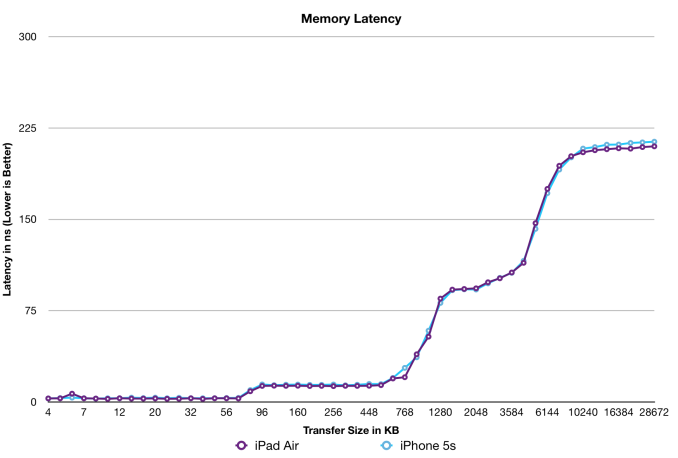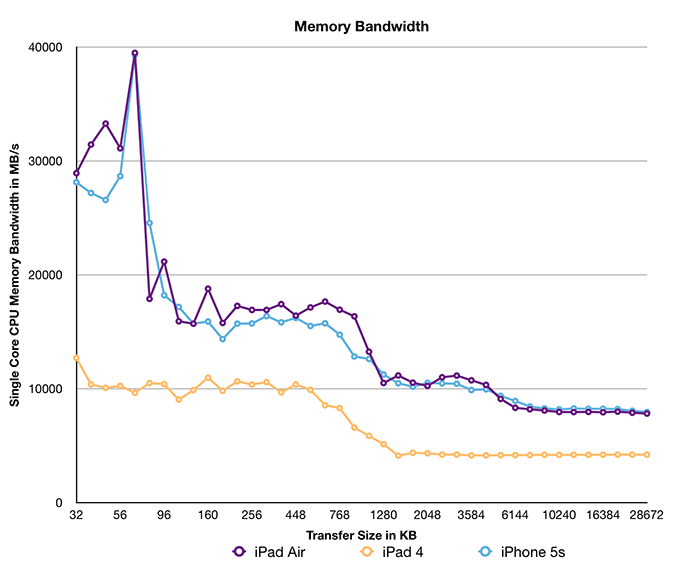The iPad Air Review
by Anand Lal Shimpi on October 29, 2013 9:00 PM ESTAn Update on Apple’s A7: It's Better Than I Thought
When I reviewed the iPhone 5s I didn’t have much time to go in and do the sort of in-depth investigation into Cyclone (Apple’s 64-bit custom ARMv8 core) as I did with Swift (Apple’s custom ARMv7 core from A6) the year before. I had heard rumors that Cyclone was substantially wider than its predecessor but I didn’t really have any proof other than hearsay so I left it out of the article. Instead I surmised in the 5s review that the A7 was likely an evolved Swift core rather than a brand new design, after all - what sense would it make to design a new CPU core and then do it all over again for the next one? It turns out I was quite wrong.
Armed with a bit of custom code and a bunch of low level tests I think I have a far better idea of what Apple’s A7 and Cyclone cores look like now than I did a month ago. I’m still toying with the idea of doing a much deeper investigation into A7, but I wanted to share some of my findings here.
The first task is to understand the width of the machine. With Swift I got lucky in that Apple had left a bunch of public LLVM documentation uncensored, referring to Swift’s 3-wide design. It turns out that although the design might be capable of decoding, issuing and retiring up to three instructions per clock, in most cases it behaved like a 2-wide machine. Mix FP and integer code and you’re looking at a machine that’s more like 1.5 instructions wide. Obviously Swift did very well in the market and its competitors at the time, including Qualcomm’s Krait 300, were similarly capable.
With Cyclone Apple is in a completely different league. As far as I can tell, peak issue width of Cyclone is 6 instructions. That’s at least 2x the width of Swift and Krait, and at best more than 3x the width depending on instruction mix. Limitations on co-issuing FP and integer math have also been lifted as you can run up to four integer adds and two FP adds in parallel. You can also perform up to two loads or stores per clock.
I don’t yet have a good understanding of the number of execution ports and how they’re mapped, but Cyclone appears to be the widest ARM architecture we’ve ever seen at this point. I’m talking wider than Qualcomm’s Krait 400 and even ARM’s Cortex A15.
I did have some low level analysis in the 5s review, where I pointed out the significantly reduced memory latency and increased bandwidth to the A7. It turns out that I was missing a big part of the story back then as well…
A Large System Wide Cache
In our iPhone 5s review I pointed out that the A7 now featured more computational GPU power than the 4th generation iPad. For a device running at 1/8 the resolution of the iPad, the A7’s GPU either meant that Apple had an application that needed tons of GPU performance or it planned on using the A7 in other, higher resolution devices. I speculated it would be the latter, and it turns out that’s indeed the case. For the first time since the iPad 2, Apple once again shares common silicon between the iPhone 5s, iPad Air and iPad mini with Retina Display.
As Brian found out in his investigation after the iPad event last week all three devices use the exact same silicon with the exact same internal model number: S5L8960X. There are no extra cores, no change in GPU configuration and the biggest one: no increase in memory bandwidth.
Previously both the A5X and A6X featured a 128-bit wide memory interface, with half of it seemingly reserved for GPU use exclusively. The non-X parts by comparison only had a 64-bit wide memory interface. The assumption was that a move to such a high resolution display demanded a substantial increase in memory bandwidth. With the A7, Apple takes a step back in memory interface width - so is it enough to hamper the performance of the iPad Air with its 2048 x 1536 display?
The numbers alone tell us the answer is no. In all available graphics benchmarks the iPad Air delivers better performance at its native resolution than the outgoing 4th generation iPad (as you'll soon see). Now many of these benchmarks are bound more by GPU compute rather than memory bandwidth, a side effect of the relative lack of memory bandwidth on modern day mobile platforms. Across the board though I couldn’t find a situation where anything was smoother on the iPad 4 than the iPad Air.
There’s another part of this story. Something I missed in my original A7 analysis. When Chipworks posted a shot of the A7 die many of you correctly identified what appeared to be a 4MB SRAM on the die itself. It's highlighted on the right in the floorplan diagram below:

A7 Floorplan, Courtesy Chipworks
While I originally assumed that this SRAM might be reserved for use by the ISP, it turns out that it can do a lot more than that. If we look at memory latency (from the perspective of a single CPU core) vs. transfer size on A7 we notice a very interesting phenomenon between 1MB and 4MB:
That SRAM is indeed some sort of a cache before you get to main memory. It’s not the fastest thing in the world, but it’s appreciably quicker than going all the way out to main memory. Available bandwidth is also pretty good:
We’re only looking at bandwidth seen by a single CPU core, but even then we’re talking about 10GB/s. Lookups in this third level cache don’t happen in parallel with main memory requests, so the impact on worst case memory latency is additive unfortunately (a tradeoff of speed vs. power).
I don’t yet have the tools needed to measure the impact of this on-die memory on GPU accesses, but in the worst case scenario it’ll help free up more of the memory interface for use by the GPU. It’s more likely that some graphics requests are cached here as well, with intelligent allocation of bandwidth depending on what type of application you’re running.
That’s the other aspect of what makes A7 so very interesting. This is the first Apple SoC that’s able to deliver good amounts of memory bandwidth to all consumers. A single CPU core can use up 8GB/s of bandwidth. I’m still vetting other SoCs, but so far I haven’t come across anyone in the ARM camp that can compete with what Apple has built here. Only Intel is competitive.












444 Comments
View All Comments
Krysto - Friday, November 1, 2013 - link
Why would the aspect ratio matter in calculating the surface area?thunng8 - Friday, November 1, 2013 - link
Of course aspect ratio affects areaTake an extreme example a tablet of length 25cm and width of 1cm. Surface area is 25cm^2. Diagonal is still 25cm. ( to be more precise 25.02cm).
gnx - Thursday, October 31, 2013 - link
As I mentioned, I find both a 7.9 inch ipad mini and galaxy note 8.0 (which is really closer to iPad Mini) both too cramped and small, as I use the table for foremost as a document reader on the go. And just to add, the Galaxy Tab 8.9 was 1280:800, thus 16:10, making even overall space closer to an iPad.Finally, for practically reasons, the Galaxy Tab 8.9 was nice, since because it's height in portrait mode was almost identical to an iPad 2/3/4, just narrower in breath, I could chose from most iPad accessories such as any carrying cases, pouches, bluetooth keyboard, etc.
yoshi1080 - Thursday, October 31, 2013 - link
I still love my iPad 3, but I'm thinking about upgrading. I do a lot of stuff on it and sometimes I wish it'd be faster. The iPad Air should be around 3–4x faster, right?Two of the most demanding tasks where I wish my iPad was faster are photo and video editing. I've already read that iMovie is supposed to be really fast on the iPad Air, so that's a clear advantage. My iPad's speed is sufficient for JPEG editing, but RAW processing (with PiRAWnha) is practically unusable. Processing RAW photos on my iPad would be my dream because photo editing on it is just so much more fun than on my iMac with the dreadfully slow Aperture – I'd be happy with getting 90% of the quality, but RAW is mandatory for me.
Up until now I thought the iPad Air would be much better suited for PiRAWnha. But now Anand writes about the RAM bottleneck due to the 64bit architecture and this makes me wonder: On the original iPad, the app often complained about too little available RAM and eventually crashed. I feel like the 1GB RAM on the iPad 3 is the reasonable minimum – would the Air be a disappointment in that regard? On the other hand, Adobe is working on bringing Lightroom and those smart DNGs to the iPad, and the beta version has even been shown running on an old iPad 2.
darkcrayon - Thursday, October 31, 2013 - link
Apps just don't need as much RAM as we think they do, especially mobile versions. Sometimes I'm surprised what can still run just fine on an iPad 2 (also helps of course that only one foreground app needs to run at a time). The Air should be 4 times faster than the iPad 3- should be no contest, especially in CPU.Death666Angel - Thursday, October 31, 2013 - link
Well, using one app at a time is fine, but browsing the web with a few tabs open and then switching to one or two other apps gets Apple device quickly ejecting stuff from RAM, where my Nexus devices are still having the pages loaded. :)fteoath64 - Thursday, October 31, 2013 - link
Thanks for the detailed review!. As I suspected the A7 behavior would have been rather different to wring out more performance out for the iPad as compared to the iphone. As you stated in the power consumption measurements, it seems the A7 is rather power hungry and only aggressive power management gets the battery life it needs. I am sure, it would be waiting for the TSMC 20nm process node as it seems this chip is just at the brink of 28nm as it is today. In making, the battery last so long without negatively impacting user performance, Apple has done a great job to achieve the balance using software. From the power draw alone, I figured out why it was clocked at such speeds instead of 1.6Ghz or 1.8Ghz. It cannot afford the power budget associated with it!.iwod - Thursday, October 31, 2013 - link
Sk Hynix Just announced a 6Gb LPDDR3. A Maximum of 3GB when 4 of them Stacked, Interesting isn't it?How about 2 Channel use? 1.5GB of Memory? May be a big company / customer would like / require this ?
While I hope Apple will give us 2GB in next generation. The reality may very well be we get 1.5GB of memory only.
bigup - Thursday, October 31, 2013 - link
is the 1GB RAM really a deal breaker? sold my ipad 3 to buy the iPad Air but now having seconds thoughts - what do you think?darkcrayon - Thursday, October 31, 2013 - link
It's not a deal breaker. You could argue in 2 years it would be better with more, but you're already the type of person that sells their less than 2 year old iPad for the latest, so... ;)